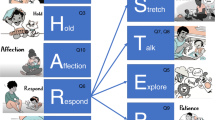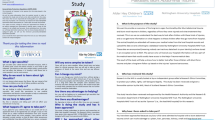Abstract
Background
Reach Out and Read (ROR) is a multi-component pediatric literacy promotion intervention. However, few studies link ROR components to outcomes. We examine associations between receipt of (1) multiple ROR components and (2) clinician modeling, a potential best practice, with enhanced home literacy environments (EHLEs) among Latino families.
Methods
We conducted secondary analyses of cross-sectional enrollment data from a randomized clinical trial at three urban community health centers between November 2020 and June 2023. Latino parents with infants 6–<9 months old were surveyed about ROR component receipt (children’s book, anticipatory guidance, modeling) and EHLE (StimQ2- Infant Read Scale). We used mixed models with clinician as a random effect, adjusting for covariates.
Results
440 Latino parent-infant dyads were included. With no components as the reference category, receipt of 1 component was not associated with EHLE. Receipt of 2 components (standardized beta = 0.27; 95%CI: 0.12–0.42) and 3 components (standardized beta = 0.33; 95% CI: 0.19–0.47) were associated with EHLE. In separate analyses, modeling was associated with EHLE (standardized beta = 0.16; 95%CI: 0.06–0.26).
Conclusion
Findings support modeling as a core ROR component. Programs seeking to enhance equity by promoting EHLE should utilize such strategies as anticipatory guidance and clinician modeling in addition to book distribution.
Impact
-
Reach Out and Read, a multi-component literacy promotion intervention, leverages primary care to promote equity in children’s early language experiences. However, few studies link Reach Out and Read components to outcomes. Among Latino parent-infant dyads, we found that implementation of two and three components, compared to none, was associated with enhanced home literacy environments, following a dose response pattern.
-
Parent report of clinician modeling was associated with enhanced home literacy environments.
-
Literacy promotion programs seeking to enhance equity by promoting enhanced home literacy environments should utilize strategies in addition to book distribution, including anticipatory guidance and modeling, to maximize impact.
This is a preview of subscription content, access via your institution
Access options
Subscribe to this journal
Receive 14 print issues and online access
$259.00 per year
only $18.50 per issue
Buy this article
- Purchase on Springer Link
- Instant access to full article PDF
Prices may be subject to local taxes which are calculated during checkout
Similar content being viewed by others
Data availability
Deidentified quantitative data and associated documentation may be made available to interested readers conducting non-profit research consistent with National Institutes of Health policy through the establishment of data sharing agreements. The timeline for release of data will be after the study is completed and main study findings from the final data set are published in peer-reviewed journals. De-identified data will be made available to researchers from accredited institutions who provide a methodologically sound proposal for use in achieving the goals of the approved proposal.
References
Cates, C. B. P., Weisleder, A. P. & Mendelsohn, A. L. Mitigating the effects of family poverty on early child development through parenting interventions in primary care. Acad. Pediatr. 16, S112–S120 (2016).
Williams, P. G. et al. School readiness. Pediatrics 144, e20191766 (2019).
Zuckerman, B. & Augustyn, M. Books and reading: evidence-based standard of care whose time has come. Acad. Pediatr. 11, 11–17 (2011).
Mendelsohn, A. L. et al. The impact of a clinic-based literacy intervention on language development in inner-city preschool children. Pediatrics 107, 130–134 (2001).
Sharif, I., Reiber, S., Ozuah, P. O. & Reiber, S. Exposure to reach out and read and vocabulary outcomes in inner city Preschoolers. J. Natl. Med. Assoc. 94, 171–177 (2002).
Golova, N., Alario, A. J., Vivier, P. M., Rodriguez, M. & High, P. C. Literacy promotion for hispanic families in a primary care setting: a randomized, controlled trial. Pediatrics 103, 993–997 (1999).
Reach out and Read. Start a Site, https://reachoutandread.org/get-involved/start-a-site/ (2022).
Edmunds, S. R. et al. A method for defining the core of a psychosocial intervention to guide adaptation in practice: reciprocal imitation teaching as a case example. Autism 26, 601–614 (2022).
King, T. M., Muzaffar, S. & George, M. P. The role of clinic culture in implementation of primary care interventions: the case of reach out and read. Acad. Pediatr. 9, 40–46 (2009).
Khandekar, A. A., Augustyn, M., Sanders, L. & Zuckerman, B. Improving early literacy promotion: a quality-improvement project for reach out and read. Pediatrics 127, e1067–e1072 (2011).
Jimenez, M. E. et al. A mixed-methods investigation examining site-level variation in reach out and read implementation. Acad. Pediatr. 23, 913–921 (2022).
Uthirasamy, N. et al. Reach out and read implementation: a scoping review. Acad. Pediatr. 23, 520–549 (2023).
Caldwell, A. et al. Literacy promotion training and implementation in pediatric continuity clinics. Acad. Pediatr. 20, 1013–1019 (2020).
Erickson, E. et al. Clinician perceptions on literacy promotion in pediatric continuity clinics. Acad. Pediatr. 22, 1192–1199 (2022).
Needlman, R., Lone, Z., Chae, R. & Abdullah, N. Literacy promotion strategies within reach out and read: an exploratory study. Clin. Pediatr. 57, 1326–1331 (2018).
Zuckerman, B. & Needlman, R. 30 years of reach out and read: need for a developmental perspective. Pediatrics 145, e20191958 (2020).
Scholastic. Kids and family reading report (6th ed.). (2017). Retrieved from http://www.scholastic.com/readingreport/downloads.htm Accessed February 23, 2017.
Jimenez, M. E. et al. Perspectives on shared reading among a sample of latino parents. Child : Care Health Dev. 45, 292–299 (2019).
Mendelsohn, A. L. et al. Primary care strategies for promoting parent-child interactions and school readiness in at-risk families: the bellevue project for early language, literacy, and education success. Arch. Pediatr. Adolesc. Med. 165, 33–41 (2011).
Cates, C. B. et al. Validation of the StimQ2: A parent-report measure of cognitive stimulation in the home. PLoS One 18, e0286708 (2023).
Vickstrom, E., Shin, H., Collazo, S. & Bauman, K. How Well—Still Good? Assessing the Validity of the American Community Survey English-Ability Question.https://www.census.gov/content/dam/Census/library/working-papers/2015/demo/SEHSD-WP2015-18.pdf (2015).
Duffee, J. H. et al. Early childhood home visiting. Pediatrics 140, e20172150 (2017).
Bleses, D., Jensen, P., Højen, A., Slot, P. & Justice, L. Implementing toddler interventions at scale: the case of “we learn together”. Early Child. Res. Q. 57, 12–26 (2021).
Kraft, M. A. Interpreting effect sizes of education interventions. Educ. Res. 49, 241–253 (2020).
Byington, C. L. et al. The good habit of reading (El Buen Habito De La Lectura): parental reactions to an enhanced reach out and read program in a clinic for the underserved. J. Health Care Poor Underserved 19, 363–368 (2008).
Jimenez, M. E. et al. Latino parents’ experiences with literacy promotion in primary care: facilitators and barriers. Acad. Pediatr. 20, 1177–1183 (2020).
Damschroder, L. J. et al. Fostering implementation of health services research findings into practice: a consolidated framework for advancing implementation science. Implement. Sci. 4, 50–50 (2009).
Kuo, A. A., Franke, T. M., Regalado, M. & Halfon, N. Parent report of reading to young children. Pediatrics 113, 1944–1951 (2004).
Reardon, S. F. & Portilla, X. A. Recent trends in income, racial, and ethnic school readiness gaps at Kindergarten Entry. AERA open 2, 233285841665734 (2016).
Acknowledgements
The authors thank the families and clinicians who participated in the study, and Nikki Shearman, PhD, for her helpful comments on a draft of this manuscript.
Funding
This work was supported by the Eunice Kennedy Shriver National Institute of Child Health and Human Development (R01HD099125), the National Center for Advancing Translational Sciences (UL1TR003017), the US Department of Health and Human Services/Health Resources and Service Administration (U3DMD32755), and the Robert Wood Johnson Foundation (74260). The content is solely the responsibility of the authors and does not necessarily represent the official views of these organizations.
Author information
Authors and Affiliations
Contributions
All authors meet ICJME criteria for authorship as follows: M.E.J., N.U. and J.R.H. contributed to the conceptualization and design of the research, the acquisition and interpretation of data, and the draft and revision of the manuscript. A.B. contributed to the extraction and interpretation of data, revision of data tables, and the draft and revision of the manuscript. K.M. and D.L. contributed to acquisition and interpretation of data, revision of data tables, and revision of the manuscript. B.F.C., T.I.M., A.L.M., P.O.S., U.R. and S.V.H. contributed to the conceptualization and design of the research, interpretation of data, and critical review and revision of the manuscript. The publication of the work described is approved by all authors. All authors approved the final manuscript and agreed to be accountable for all aspects of the work.
Corresponding author
Ethics declarations
Competing interests
The authors have no conflicts of interest to disclose. Findings were presented in part at the 2023 Pediatric Academic Societies Meeting in Washington, DC.
Consent to participate
Participant consent was required for study participation.
Additional information
Publisher’s note Springer Nature remains neutral with regard to jurisdictional claims in published maps and institutional affiliations.
Supplementary Information
Rights and permissions
Springer Nature or its licensor (e.g. a society or other partner) holds exclusive rights to this article under a publishing agreement with the author(s) or other rightsholder(s); author self-archiving of the accepted manuscript version of this article is solely governed by the terms of such publishing agreement and applicable law.
About this article
Cite this article
Jimenez, M.E., Uthirasamy, N., Hemler, J.R. et al. Maximizing the impact of reach out and read literacy promotion:anticipatory guidance and modeling. Pediatr Res (2023). https://doi.org/10.1038/s41390-023-02945-z
Received:
Revised:
Accepted:
Published:
DOI: https://doi.org/10.1038/s41390-023-02945-z



